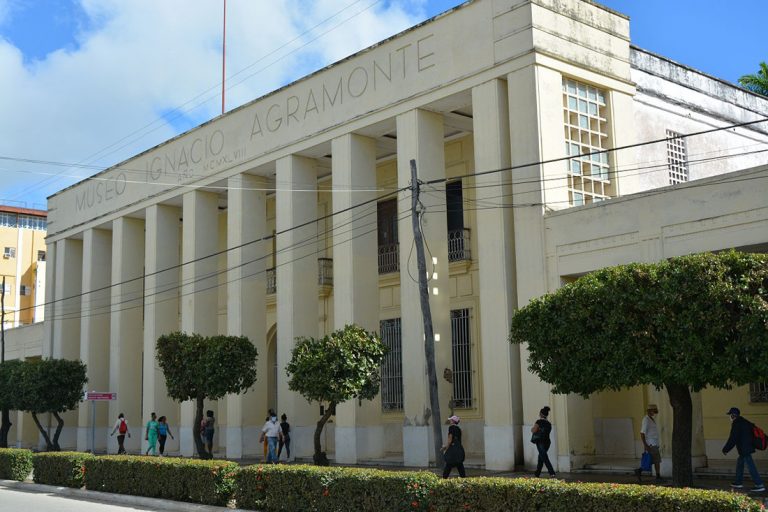The Ignacio Agramonte Provincial Museum is one of the most prestigious in Cuba, on December 23th it celebrates its 65th anniversary, but contrary to what many believe, it was not the first in the city.
At the beginning of this passion to avoid forgetting our beautiful history, we approach today from the institution.
The first Museum
In 1920, a woman from Camagüey, proud of her mambises, invited all Camagüey people of good will to donate any family item related to the libertarian struggles. It was Mariana Betancourt and Garay who was in charge of such a noble effort; with the pieces that she managed to put together she opened a small room in the old government house.
When the Museum project began, her collection was formed and today many of these pieces tell the history of Camagüey, as is the case with those that belonged to Amalia and Ignacio’s wedding tableware.
The future of the property
 Since 1941, the Board of the Ignacio Agramonte Museum led by Mario Aquiles Betancourt together with Ignacio Eduardo Agramonte, as vice president and historian Oscar Silva Muñoz del Canto, as its secretary, began to function and prepare its specialists, many in the prestigious institute Smithsonia.
Since 1941, the Board of the Ignacio Agramonte Museum led by Mario Aquiles Betancourt together with Ignacio Eduardo Agramonte, as vice president and historian Oscar Silva Muñoz del Canto, as its secretary, began to function and prepare its specialists, many in the prestigious institute Smithsonia.
Between 1945 and 1948 the building adaptation works were carried out. The Museum is one of the most important centers in the country due to the antiquity, diversity and great patrimonial value of the collections it holds, made up of large and diverse collections of natural history from Cuba and the world, exceptional for their rarity, antiquity and variety.
The institution is renowned for the plastic arts room, since its collection is considered the most complete in the interior of the country, for collecting the history of that manifestation with original pieces by great creators such as: Landaluce, Enrique Collazo, Víctor Manuel, René Portocarrero, Fidelio Ponce and Mariano Rodríguez, among others.
It also has the history room of Puerto Príncipe, where I was able to take a journey through time, led by specialists Yudenia Días Rodríguez and Xiomara Lezcano Lovaco. The tour was a privilege that I want to share.
The tour
With a lot of passion for the country’s history and an experience of more than 20 years, my guides in this adventure to Camagüey since its foundation, took me to the map of the two locations that the town had before the current one and there we began.
 It is not easy to summarize 500 years, but I was able to appreciate the development in its various aspects: arts and crafts stand out, with the influence of European techniques; French crafts based on human hair are an extravagant curiosity.
It is not easy to summarize 500 years, but I was able to appreciate the development in its various aspects: arts and crafts stand out, with the influence of European techniques; French crafts based on human hair are an extravagant curiosity.
A stop in front of the showcase dedicated to slavery overwhelms me, appreciating so much blacksmithing to subdue those people, speaks of those terrible times, where the rich drank and ate excessively, while the serfdom suffered hardships.
We arrived at the site of the struggles for independence, our proud heroes of this land, they left a lot of spirituality and almost nothing material, from Joaquín Agüero the bars of his cell, his pocket watch and tie, tell us about their selflessness and his dedication to the homeland.
The eponymous hero of this land has a notorious space; his love affair with Amalia is part of the museum collection, which shows Amalia’s rosary and Ignacio’s watch, as well as the teapot and milk jug from his home.
Other pieces of high value stand out, such as the instruments of Blessed Father Olallo and the capitular masses that marked the passage of our home from town to city.
 The maps and blueprints of the City Hall of Puerto Príncipe and papers of the great figures of the national history, allowed us to rewrite the rich history that defines Camagüey.
The maps and blueprints of the City Hall of Puerto Príncipe and papers of the great figures of the national history, allowed us to rewrite the rich history that defines Camagüey.
I am late and I must return, a single trip to yesterday leaves me expectant, I must return for a new experience, which can undoubtedly be seen in each visit to the Provincial Museum of Camagüey, a jewel of architecture; Once a cavalry barracks, which since 1955 has treasured symbols of the city’s history and culture, so that our history can always be remembered.
Translated by: Aileen Álvarez García






